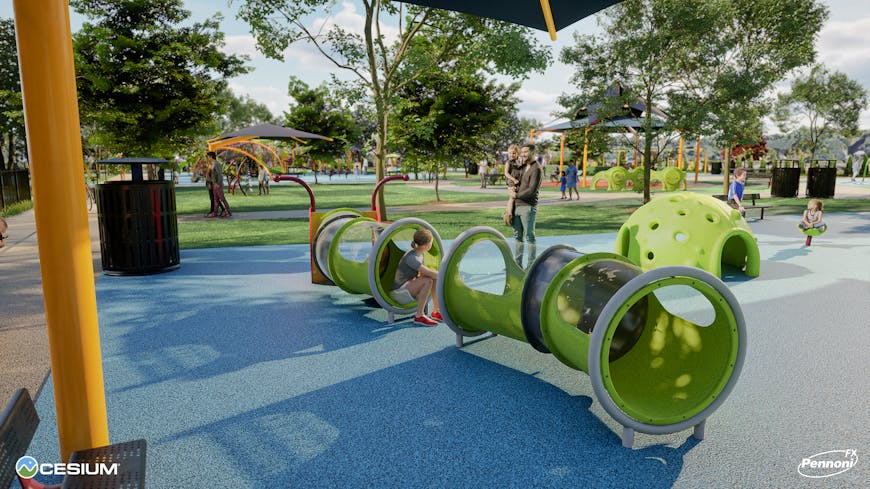Pennoni Transforms Engineering Models with Cesium
As AEC projects increasingly require public input and organizations prefer plans with realism for their own understanding, Pennoni is moving engineering from graph paper to streaming 3D models with Cesium for Unreal and Google Photorealistic 3D Tiles.

Proposed “dolphin” cylinder protection at Delaware River and Bay Authority (DRBA)’s Delaware Memorial Bridge. Courtesy Pennoni.
Multidisciplinary engineering firm Pennoni—also our neighbor, headquartered in Philadelphia—serves clients across the US and has recently created immersive visualizations for clients in Florida; Virginia; Washington, DC; Maryland; Delaware; Pennsylvania; New Jersey; and Massachusetts. Whether it’s for a revamped playground, a shared-use path, a new neighborhood, bridge replacement, or a streetscape, Pennoni is bringing 3D interactions to architecture, engineering, and construction (AEC) planning and approvals. For example, Pennoni recently completed a digital twin of the new “dolphin” cylinder protection system for the Delaware River and Bay Authority (DRBA)’s Delaware Memorial Bridge, a critical twin suspension bridge crossing the Delaware River.
The firm has been heavily involved with design visualization and the creation of digital twins for engineering projects since 2015. That’s when Pennoni in-house viz duo Joe Spadea, PE, associate vice president, Pennoni FX Studios (PFX) visualization practice leader, and Steven Lewis, senior engineering technician, led the formation and creation of the PFX team. Since that time, there have been new faces and technologies to grow the firm’s capabilities. The firm began using Cesium in 2023, when Mike Sulesky, design visualization specialist at Pennoni, met the Cesium team at a Drexel University event. The PFX Studios team found that integrating Cesium with tools they were already using was easier and saved time, freeing up days of work to improve other facets of a project. With Cesium for Unreal and Google Photorealistic 3D Tiles, they no longer needed to hand-model a project’s surroundings and could instead create suitable scenes and infrastructure massing in house.
“It’s a constant balance of quality, budget, and time. Cesium allows us some flexibility of budget and time,” said Tim Timmons, senior design visualization specialist at Pennoni.

Digital twin of Jake's Place, an inclusive playground in Vineland, New Jersey. Courtesy Pennoni.
Pennoni creates interior and exterior 3D renderings and animations for its clients’ individual projects. For interiors, the firm’s Unreal Engine artists combine manual modeling with marketplace assets. For exteriors, Pennoni’s engineers, with collaborating architects, create 3D models for proposed structures using CAD data, point clouds, or photogrammetry. Pennoni loads these directly into Unreal Engine, ensuring accurate placement and lighting with Cesium for Unreal, and streams Google Photorealistic 3D Tiles via Cesium ion for real-world urban context, so the future view is clear.
Google Maps Platform’s Photorealistic 3D Tiles were designed to scale from city blocks to citywide, immersing users in the surroundings they expect to see. Photorealistic 3D Tiles use the Open Geospatial Consortium (OGC) community standard 3D Tiles format. This format, created by Cesium, efficiently streams massive amounts of data required to display details for both collaborative planning and public awareness.
Pennoni reports that including Cesium in its digital innovation has helped the firm impress clients, win work, and market Pennoni itself, as the engineers work hand in hand with the company’s corporate communications team.
“Rather than waiting years for a project to be completed, and then capture and post photos, we can show visualizations immediately, in present day,” explained Spadea.
Proposed condominiums set against the Florida Gulf Coast. Courtesy Pennoni.
Earlier this month, Cesium announced we joined Bentley Systems, a leading infrastructure engineering software company, via acquisition. Together with Bentley, Cesium provides a complete platform for building digital twin experiences for the natural and built environment, with a strong commitment to open source, open standards, and open APIs.
"The recent acquisition is a great fit and a win for everyone. Pennoni has utilized Bentley tools and has a long-standing partnership with Bentley, so this is a welcome next step for us. It's remarkable as well that all three firms are headquartered in the Delaware Valley. Move over, Silicon Valley,” said Spadea.
To immerse your AEC clients in accurate, realistic 3D and better allocate your resources, sign up for a Cesium ion account.